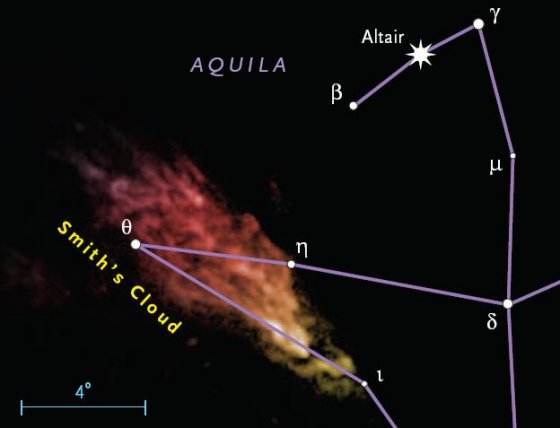MessageToEagle.com – “We report the first detection of magnetic fields associated with the Smith High Velocity Cloud… The presence of the magnetic field may contribute to the survival of high velocity clouds like the Smith Cloud as they move from the Galactic halo to the disk. We expect these data to provide a test for magnetohydrodynamic simulations of infalling gas,” according to a new research.
Astronomers using the Karl G. Jansky Very Large Array (VLA) and Robert C. Byrd Green Bank Telescope (GBT) have discovered a magnetic field in the Smith Cloud’s interior, which may protect it during its meteoric plunge into the disk of our Galaxy.
The Smith Cloud, a gigantic streamer of hydrogen gas that is on a collision course with the Milky Way Galaxy, hurtling toward the Milky Way at more than 150 miles per second. The impact will take place in approximately 30 million years.
The origin of the Smith Cloud’s field remains a mystery.
This discovery could help explain how so-called high velocity clouds (HVCs) remain mostly intact during their mergers with the disks of galaxies, where they would provide fresh fuel for a new generation of stars.
When it does, astronomers believe, it will set off a spectacular burst of star formation. But first, it has to survive careening through the halo, or atmosphere, of hot ionized gas surrounding the Milky Way.
“The million-degree upper atmosphere of the Galaxy ought to destroy these hydrogen clouds before they ever reach the disk, where most stars are formed,” said Alex Hill, an astronomer at Australia’s Commonwealth Scientific and Industrial Research Organization (CSIRO) and lead author of a paper.

“New observations reveal one of these clouds in the process of being shredded, but a protective magnetic field shields the cloud and may help it survive its plunge.”
Many hundreds of HVCs zip around our Galaxy, but their obits seldom correspond to the rotation of the Milky Way.
This leads astronomers to believe that HVCs are the left-over building blocks of galaxy formation or the splattered remains of a close galactic encounter billions of years ago.
The only way to observe it is with exquisitely sensitive radio telescopes, like the GBT, which can detect the faint emission of neutral hydrogen. If it were visible with the naked eye, the Smith Cloud would cover almost as much sky as the constellation Orion.
“The field we observe now is too large to have existed in its current state when the cloud was formed,” said Hill. “The field was probably magnified by the cloud’s motion through the halo.”
“The Smith Cloud is unique among high-velocity clouds because it is so clearly interacting with and merging with the Milky Way,” said Felix J. Lockman, an astronomer at the National Radio Astronomy Observatory (NRAO) in Green Bank, W.Va.
“Its comet-like appearance indicates it’s already feeling the Milky Way’s influence.”
When the Smith Cloud eventually merges with the Milky Way, it could produce a bright ring of stars similar to the one relatively close to our Sun known as Gould’s Belt.
MessageToEagle.com






